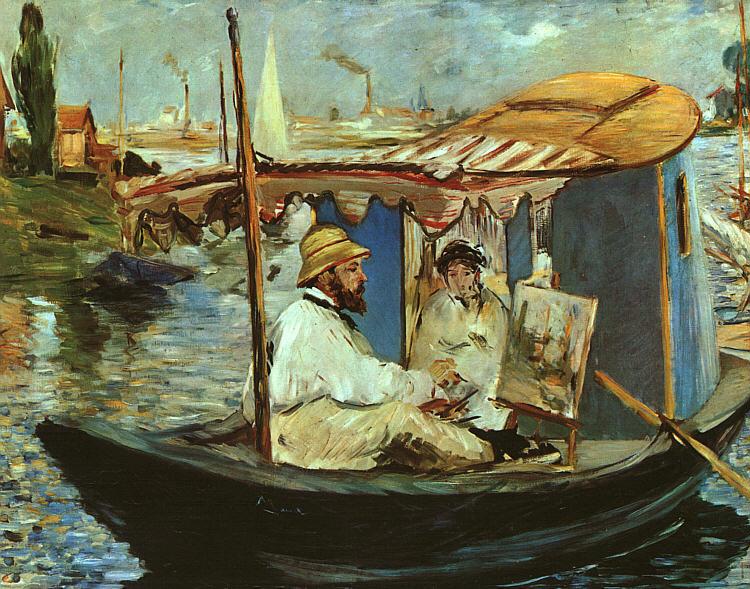Beskrivelse
The painting "Monet on his Studio Boat" by Édouard Manet, painted in 1874, is a work that transcends the mere representation of an artist in his creative environment to become a reflection on the nature of art itself. In this work, Manet captures an intimate and almost poetic moment of his contemporary Claude Monet, who is portrayed in his particular work location, a boat that allowed him to get closer to the changing light and aquatic landscapes that so fascinated him.
Visually, the painting is composed of a set of elements that combine Monet's figure with his natural surroundings. Monet, dressed in a simple and contemporary style, is immersed in his artistic work, with a canvas in his hand, although the work he is creating is not clearly visible. This compositional choice suggests that the creative process is as important as the final result. The representation of Monet on a boat, between the blue tones of the water and the greens of the surrounding vegetation, establishes a dialogue between man and nature, one of the constants in impressionist painting.
The colours in this work are particularly striking. Manet employs a soft palette, dominated by blues and greens, evoking the serenity of the natural environment. Natural light, filtering through and reflecting off the water, translates into fluid brushstrokes that suggest the movement and dynamism of the aquatic landscape. The loose brushstroke technique anticipates the formal language of Impressionism, which is characterised by the capture of light and colour in fleeting moments.
The work is also notable for its asymmetrical composition, where Monet is slightly offset to the left, allowing the viewer's eye to flow across the canvas, exploring both the figure and the aquatic surroundings. The tilt of the boat and the gentle ripples of the water complement the sense of freedom and movement, creating a space in which the viewer can almost feel part of the scene.
Furthermore, “Monet in his Studio Boat” is a work that can also be read as a love letter to artistic practice and to the friendship between the two painters. Manet and Monet shared not only a vision towards art, but also a personal bond that was reflected in their interactions during that period. The portrait of Monet in his natural element shows an artist not only in his role as a creator, but in his deeper connection to the beauty that surrounds him, encapsulating the essence of the Impressionist movement.
It is interesting to note that this work is set at a key moment in art history, when Impressionism was beginning to establish itself as a dominant force in the art landscape of the time. Manet, although often associated with Realism and a precursor to modern trends, is here collaborating in spirit with Monet, the epitome of Impressionism, which adds an intriguing layer of intertextuality to the work. Through this painting, the viewer is not only witnessing Monet's work, but also the evolution of an artistic movement that laid the groundwork for modern art.
In the end, "Monet on his Studio Boat" is more than just a portrait; it is a celebration of creativity and experimentation in art, a reflection of the interrelationships that exist between artists and their landscapes, and a testament to the time and space that painting can capture and eternalize.
KUADROS ©, a famous painting on your wall.
Hand-made oil painting reproductions, with the quality of professional artists and the distinctive seal of KUADROS ©.
Painting reproduction service with satisfaction guarantee. If you are not completely satisfied with the replica of your painting, we will refund 100% of your money.

